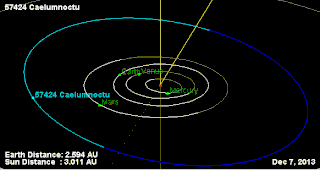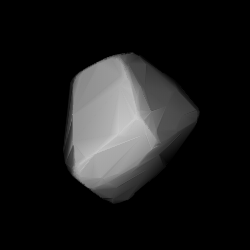827 Wolfiana, provisional designation 1916 ZW, is a Florian asteroid from the inner regions of the asteroid belt, approximately 8 kilometers in diameter. It was discovered at Vienna Observatory on 29 August 1916, by Austrian astronomer Johann Palisa, who named it after German astronomer Max Wolf. The assumed stony asteroid has a rotation period of 4.0654 hours.
1047 Geisha, provisional designation 1924 TE, is a stony Florian asteroid from the inner regions of the asteroid belt, approximately 11 kilometers in diameter. It was discovered on 17 November 1924, by German astronomer Karl Reinmuth at the Heidelberg-Königstuhl State Observatory in southwest Germany. The asteroid was named after the British musical The Geisha.

57424 Caelumnoctu, provisional designation 2001 SP22, is an Eoan asteroid from the outer regions of the asteroid belt, approximately 7 kilometers in diameter. It was discovered on 16 September 2001, by astronomers of the Lincoln Near-Earth Asteroid Research at Lincoln Laboratory's Experimental Test Site near Socorro, New Mexico. The asteroid was named for the BBC television programme The Sky at Night.
9916 Kibirev, provisional designation 1978 TR2, is a Koronian asteroid from the outer regions of the asteroid belt, approximately 6 kilometers (3.7 miles) in diameter. It was discovered on 3 October 1978, by astronomer Nikolai Chernykh at the Crimean Astrophysical Observatory in Nauchnij, on the Crimean peninsula. The likely S-type asteroid has a rotation period of about 15.2 hours and was named after Russian informatician Sergej Kibirev.
11277 Ballard, provisional designation 1988 TW2, is a Phocaea asteroid from the inner regions of the asteroid belt, approximately 6.3 kilometers (3.9 miles) in diameter. It was discovered on 8 October 1988, by American astronomer couple Carolyn and Eugene Shoemaker at the Palomar Observatory in California. The assumed S-type asteroid has a rotation period of at least 10 hours. It was named for American marine scientist Robert Ballard.

2708 Burns is a carbonaceous Themistian asteroid from the outer regions of the asteroid belt, approximately 19 kilometers in diameter. It was discovered on 24 November 1981, by American astronomer Edward Bowell at the Anderson Mesa Station near Flagstaff, Arizona, in the United States. It was named after American planetary scientist Joseph A. Burns. The likely elongated B-type asteroid has a rotation period of 5.3 hours.
3268 De Sanctis, provisional designation 1981 DD, is a Vestian asteroid from the inner regions of the asteroid belt, approximately 6 kilometers in diameter. It was discovered on 26 February 1981, by European astronomers Henri Debehogne and Giovanni de Sanctis at ESO's La Silla Observatory in northern Chile. The asteroid was named after the second discoverer. The assumed S-type asteroid has a rotation period of 17 hours.
1452 Hunnia, provisional designation 1938 DZ1, is a carbonaceous Meliboean asteroid from the outer regions of the asteroid belt, approximately 20 kilometers in diameter. It was discovered on 26 February 1938, by Hungarian astronomer György Kulin at the Konkoly Observatory in Budapest. The asteroid was named in honor of the Hungarian nation.
3714 Kenrussell, provisional designation 1983 TT1, is a Eunomian asteroid from the central regions of the asteroid belt, approximately 10 kilometers (6 miles) in diameter. It was discovered on 12 October 1983, by American astronomer Edward Bowell at the Anderson Mesa Station near Flagstaff, Arizona, in the United States. It was named for Australian astronomer Kenneth S. Russell. The presumably stony asteroid has a rotation period of 5.25 hours.
1303 Luthera, provisional designation 1928 FP, is a dark asteroid and the parent body of the Luthera family, located in the outermost regions of the asteroid belt. It measures approximately 90 kilometers in diameter. The asteroid was discovered on 16 March 1928, by astronomer Friedrich Schwassmann at the Bergedorf Observatory in Hamburg, Germany, and later named after German astronomer Robert Luther.
1696 Nurmela, provisional designation 1939 FF, is a Baptistina asteroid from the inner regions of the asteroid belt, approximately 10 kilometers in diameter. It was discovered on 18 March 1939, by Finnish astronomer Yrjö Väisälä at Turku Observatory in Southwest Finland, and named after Finnish academician Tauno Nurmela. The possibly elongated asteroid has a rotation period of 3.15 hours.

5208 Royer (prov. designation: 1989 CH1) is a stony Marian asteroid from the central regions of the asteroid belt, approximately 8 kilometers (5 miles) in diameter. It was discovered on 6 February 1989, by astronomer Eleanor Helin at the Palomar Observatory. The S-type asteroid has a rotation period of 3.87 hours and was named after American priest and amateur astronomer, Ronald Royer.
6229 Tursachan, provisional designation 1983 VN7, is a Themistian asteroid from the outer regions of the asteroid belt, approximately 10 kilometers (6 miles) in diameter. It was discovered on 4 November 1983, by American astronomer Brian Skiff at Lowell's Anderson Mesa Station near Flagstaff, Arizona, in the United States. The presumed C-type asteroid has a rotation period of 16.6 hours and is possibly elongated. It was named after a Gaelic word meaning "Standing Stones".
1302 Werra, provisional designation 1924 SV, is a Themistian asteroid from the outer regions of the asteroid belt, approximately 30 kilometers in diameter. It was discovered on 28 September 1924, by German astronomer Karl Reinmuth at the Heidelberg-Königstuhl State Observatory. The asteroid was named for the river Werra in central Germany.
1688 Wilkens, provisional designation 1951 EQ1, is a Mitidika asteroid from the central region of the asteroid belt, approximately 16 kilometers in diameter. It was discovered on 3 March 1951, by Argentine astronomer Miguel Itzigsohn at La Plata Observatory in the Province of Buenos Aires, Argentina, and named after astronomer Alexander Wilkens.
10241 Miličević, provisional designation 1999 AU6, is a carbonaceous Themistian asteroid from the outer regions of the asteroid belt, approximately 11 kilometers (6.8 miles) in diameter. It was discovered on 9 January 1999, by Croatian astronomer Korado Korlević at the Višnjan Observatory in Croatia. The C-type asteroid has a short rotation period of 3.87 hours and was named after hermit and amateur astronomer Don Nikola Miličević.

1521 Seinäjoki, provisional designation 1938 UB1, is a Brasilia asteroid from the outer region of the asteroid belt, approximately 14 kilometers in diameter. It was discovered on 22 October 1938, by Finnish astronomer Yrjö Väisälä at the southwestern Turku Observatory, Finland. The asteroid was later named after the Finnish city of Seinäjoki.
7449 Döllen, provisional designation 1949 QL, is a stony Florian asteroid from the inner regions of the asteroid belt, approximately 3.5 kilometers in diameter. It was discovered on 21 August 1949, by German astronomer Karl Reinmuth at the Heidelberg Observatory in southwest Germany. The likely S-type asteroid has a rotation period of 10 hours. It was named after German astronomer Wilhelm Döllen.
31179 Gongju, provisional designation 1997 YR2, is a stony Nysian asteroid from the inner regions of the asteroid belt, approximately 5 kilometers (3 miles) in diameter. It was discovered on 21 December 1997, by Japanese amateur astronomer Naoto Sato at his Chichibu Observatory near Tokyo, central Japan. The S-type asteroid has a rotation period of 4.8 hours and possibly an elongated shape. It was named for the South Korean city of Gongju.
57868 Pupin, provisional designation 2001 YD, is a dark Erigonian asteroid and slow rotator from the inner regions of the asteroid belt, approximately 3.5 kilometers in diameter. It was discovered on December 17, 2001, by astronomers of Near-Earth Asteroid Tracking (NEAT) at the Palomar Observatory in California, United States. The asteroid was named after Serbian–American physicist Mihajlo Pupin.




